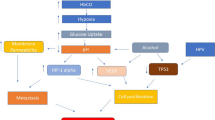Background:
Tumor hypoxia has an impact on the outcome of cancer patients treated with radiotherapy. The validity of endogenous markers such as hypoxia-inducible factor-1α (HIF-1α) and carbonic anhydrase isozyme IX (CAIX) to detect therapeutically relevant levels of hypoxia within tumors is controversially discussed. Furthermore, the association of these hypoxia markers with tumor markers or tumor oxygenation parameters is of importance for understanding the relationship between the different factors.
Patients and Methods:
Tumor tissue sections of 34 patients with advanced head-and-neck cancer treated with radio(chemo)therapy were assessed by immunohistochemistry for the expression of HIF-1α and CAIX. The relationships of both markers with tumor oxygenation parameters, molecular factors like P53, OPN, VEGF, VHL, survivin, and Ki67 levels, and clinical parameters were studied.
Results:
Bivariate analysis showed a significant correlation of HIF-1α expression with high P53 and high OPN expression, high serum VEGF levels, and low VHL and low Ki67 expression. The CAIX expression was inversely correlated with pH value and directly correlated with T-stage. However, no correlation was found between HIF-1α and CAIX expression.
Neither in a univariate Cox proportional hazard regression nor in a Kaplan-Meier analysis did expression of HIF-1α or CAIX have a significant impact on clinical outcome. However, in a Kaplan-Meier analysis, the combination of both factors showed that patients with intratumoral overexpression of either HIF-1α or CAIX or both markers died on average 2 years earlier than patients whose tumors had low expression of both factors (p < 0.05).
Conclusion:
Expression of HIF-1α and CAIX was correlated with different tumor parameters. Only combined HIF-1α and CAIX expression was significantly predictive of patients’ overall survival.
Hintergrund:
Hypoxie in Tumoren hat einen Einfluss auf die Prognose von Tumorpatienten, die eine Strahlentherapie erhielten. Der Einsatz von endogenen Markern wie hypoxieinduzierbarem Faktor-1α (HIF-1α) und Carboanhydrase-Isoenzym IX (CAIX) zur Identifizierung therapierelevanter hypoxischer Tumorbereiche wird jedoch kontrovers diskutiert. Die Untersuchung der Assoziation von Tumormarkern und tumorrelevanten Oxygenierungsparametern ist deshalb von wesentlicher Bedeutung für das Verständnis der Beziehung dieser biologischen Indikation.
Patienten und Methodik:
An Tumorgewebeschnitten von 34 Patienten mit radio(chemo)therapierten fortgeschrittenen Kopf-Hals-Tumoren wurde immunhistochemisch die Expression von HIF-1α und CAIX untersucht. Die Expression beider Marker wurde mit Tumoroxygenierungsparametern, der Expression molekularer Faktoren wie P53, OPN, VEGF, VHL, Survivin und Ki67 sowie klinischen Parametern in Beziehung gesetzt.
Ergebnisse:
Bivariate Analysen zeigten eine signifikante Korrelation zwischen einer HIF-1α-Expression und einer hohen P53- und OPN-Expression, einem hohen Serum-VEGF-Gehalt sowie einer geringeren VHL- und Ki67-Expression. Eine hohe CAIX-Expression korrelierte invers mit dem pH-Wert und direkt mit dem T-Stadium. Zwischen der HIF-1α- und CAIX-Expression wurde keine Korrelation nachgewiesen.
Mittels univariater Cox-Regressions- bzw. Kaplan-Meier-Analyse zeigte weder die HIF-1α- noch die CAIX-Expression einen signifikanten Einfluss auf das Überleben. Die Kombination der beiden Faktoren ergab dagegen in der Kaplan-Meier-Analyse, dass Patienten mit intratumoraler Überexpression von HIF-1α oder CAIX oder beiden Markern durchschnittlich 2 Jahre früher verstarben als Patienten, deren Tumoren eine geringe Expression beider Faktoren aufwiesen (p < 0,05).
Schlussfolgerung:
Die Expression von HIF-1α und CAIX korrelierte mit verschiedenen Tumorparametern. Erst die Kombination der Marker HIF-1α und CAIX zeigte einen signifikanten prädiktiven Einfluss auf das Gesamtüberleben von Patienten mit Kopf-Hals-Tumoren nach einer Radio(chemo)therapie.
Similar content being viewed by others
Author information
Authors and Affiliations
Corresponding author
Additional information
An erratum to this article is available at http://dx.doi.org/10.1007/s00066-008-9813-1.
Rights and permissions
About this article
Cite this article
Kappler, M., Taubert, H., Holzhausen, HJ. et al. Immunohistochemical Detection of HIF-1α and CAIX in Advanced Head-and-Neck Cancer. Strahlenther Onkol 184, 393–399 (2008). https://doi.org/10.1007/s00066-008-1813-7
Received:
Accepted:
Published:
Issue Date:
DOI: https://doi.org/10.1007/s00066-008-1813-7




